A comparative study on degradation kinetics and toxicity changes of BPA and BPS in UV-based advanced oxidation processes
IF 7.7
2区 环境科学与生态学
Q1 ENVIRONMENTAL SCIENCES
引用次数: 0
Abstract
Bisphenol A (BPA) and Bisphenol S (BPS) are endocrine-disrupting chemicals that pose significant ecological and health risks due to their persistence and toxicity. This study presents a comprehensive comparison of three UV-based advanced oxidation processes (UV-AOPs: UV/Cl, UV/PDS, and UV/H2O2) for degrading BPA and BPS, with an emphasis on correlating degradation efficiency to the toxicity of transformation products (TPs). Using a 500 W mercury vapor lamp, we demonstrate how differences in electronic properties (e.g., BPA's electron-rich rings vs. BPS's electron-withdrawing sulfonyl group) influence radical selectivity (SO4•−, •OH, RCS) and by-product risks. The effects of oxidant dosage, pH, and dissolved organic matter were examined. The toxicity of degradation by-products was evaluated using an integrated approach combining ECOSAR predictions and Vibrio fischeri bioassays to reveal critical trade-offs between degradation rates and TP safety. The UV/PDS system demonstrated the highest BPA removal efficiency (96.5 % in 10 min, k = 0.3185 ± 0.034 min−1) under alkaline conditions, primarily via sulfate radicals (SO4•−). In contrast, BPS degradation was less efficient (k = 0.0910 min−1) due to the lower reactivity of its sulfonyl group. The UV/Cl process generated chlorinated by-products, such as TP07, with toxicity levels 1.5 to 2.0 times higher than the parent compounds, while UV/H2O2 produced hydroxylated by-products that were 25 % more toxic than BPA. Notably, chlorinated derivatives increased toxicity in BPA but reduced it in BPS due to steric hindrance from the sulfonyl group, a structural nuance not previously reported in AOP studies. Oxidized by-products were generally less toxic, whereas fragmented products exhibited higher toxicity than their precursors. These findings support pollutant-specific optimization of UV-AOPs, identifying UV/PDS as the most effective for BPA degradation while emphasizing the need for sulfonyl-targeted refinement in BPS treatment.

双酚A和BPS在uv基深度氧化过程中降解动力学及毒性变化的比较研究
双酚A (BPA)和双酚S (BPS)是内分泌干扰化学物质,由于其持久性和毒性,对生态和健康构成重大风险。本研究全面比较了三种基于UV- aops的高级氧化工艺(UV /Cl、UV/PDS和UV/H2O2)对BPA和BPS的降解效果,重点研究了降解效率与转化产物毒性之间的关系。使用500 W汞灯,我们展示了电子性质的差异(例如,BPA的富电子环与BPS的吸电子磺酰基)如何影响自由基选择性(SO4•−,•OH, RCS)和副产物风险。考察了氧化剂用量、pH值和溶解有机物的影响。使用ECOSAR预测和费氏弧菌生物测定相结合的综合方法评估降解副产物的毒性,以揭示降解率和TP安全性之间的关键权衡。在碱性条件下,UV/PDS系统主要通过硫酸盐自由基(SO4•−)去除BPA,在10 min内达到96.5% (k = 0.3185±0.034 min−1)。相比之下,由于其磺酰基的反应活性较低,BPS的降解效率较低(k = 0.0910 min−1)。UV/Cl工艺产生的氯化副产物,如TP07,毒性水平比母体化合物高1.5至2.0倍,而UV/H2O2产生的羟基化副产物的毒性比BPA高25%。值得注意的是,氯化衍生物增加了BPA的毒性,但由于磺酰基的空间位阻,降低了BPS的毒性,这是AOP研究中以前没有报道的结构上的细微差别。氧化副产物通常毒性较低,而碎片化产物的毒性高于其前体。这些发现支持了UV- aops的污染物特异性优化,确定了UV/PDS对BPA降解最有效,同时强调了在BPS处理中需要磺酰靶向精化。
本文章由计算机程序翻译,如有差异,请以英文原文为准。
求助全文
约1分钟内获得全文
求助全文
来源期刊

Environmental Research
环境科学-公共卫生、环境卫生与职业卫生
CiteScore
12.60
自引率
8.40%
发文量
2480
审稿时长
4.7 months
期刊介绍:
The Environmental Research journal presents a broad range of interdisciplinary research, focused on addressing worldwide environmental concerns and featuring innovative findings. Our publication strives to explore relevant anthropogenic issues across various environmental sectors, showcasing practical applications in real-life settings.
 求助内容:
求助内容: 应助结果提醒方式:
应助结果提醒方式:


